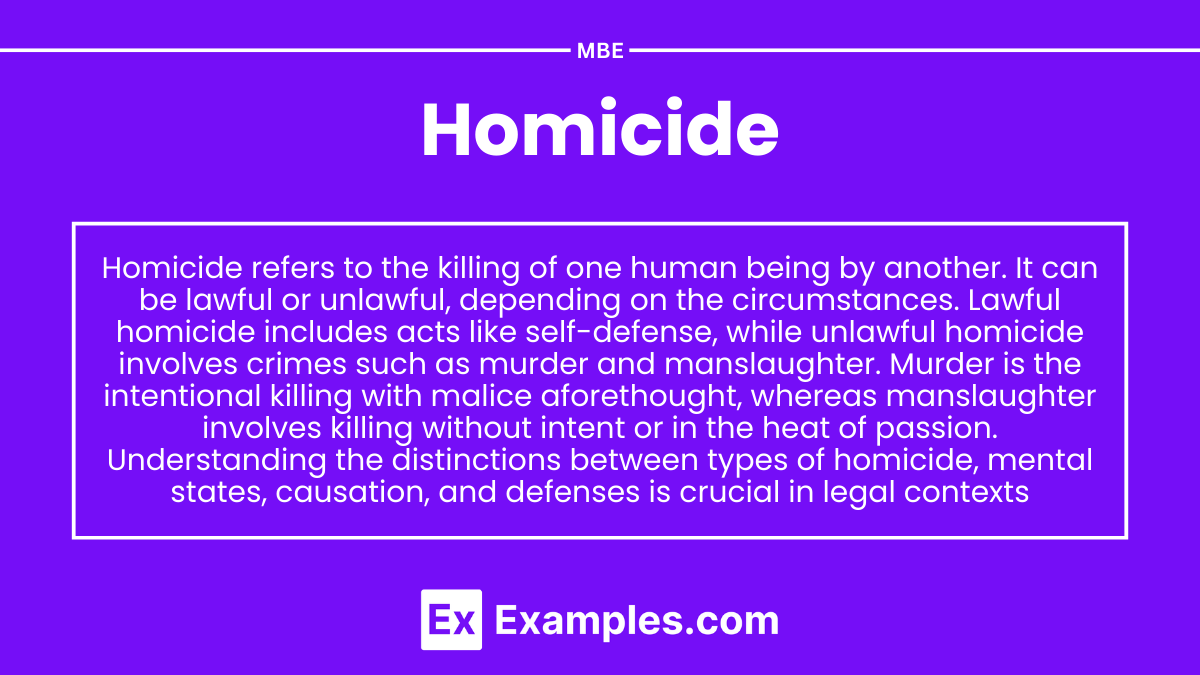Preparing for the MBE Exam requires a solid grasp of "Homicide," encompassing the theoretical and practical aspects of criminal law. This includes understanding the distinctions between types of homicide, such as murder and manslaughter, the requisite mental states, and the legal doctrines like felony murder and provocation. Proficiency in analyzing fact patterns, applying statutes, and distinguishing nuances in defenses is crucial for navigating complex homicide scenarios effectively.
Learning Objectives
In studying Homicide for the MBE Exam, you should learn to understand its critical role in criminal law and its application to fact patterns. Homicide encompasses various categories, such as murder, manslaughter, and negligent homicide, each requiring distinct mental states and elements. Understanding the doctrines of felony murder, causation, and defenses like self-defense and insanity is essential. These concepts are vital for analyzing scenarios, applying laws, and distinguishing between degrees of culpability. Mastery of homicide law ensures accurate issue-spotting, refined reasoning, and strong performance, which are critical for success in the MBE Exam.
What is Homicide?
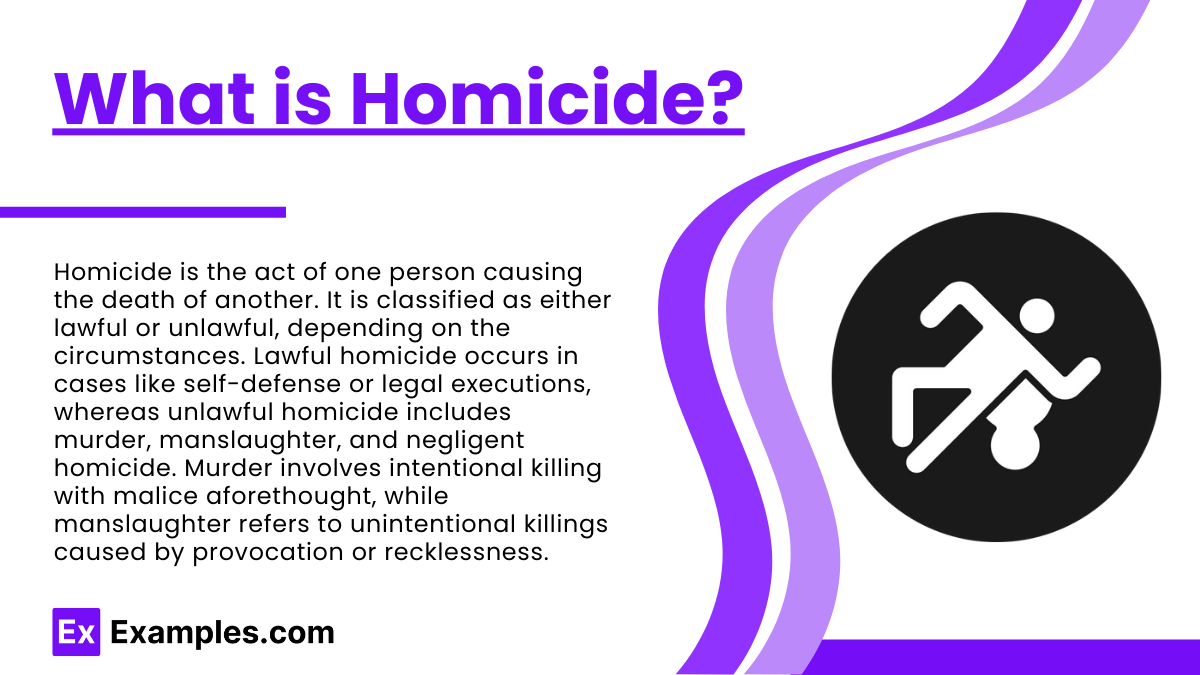
Homicide refers to the act of one individual causing the death of another. It is a broad term that encompasses various circumstances under which such an act may occur, ranging from lawful to unlawful contexts. Homicide can be categorized into different types, including murder, manslaughter, and justifiable homicide, each distinguished by intent, circumstances, and legality. For example, murder involves intentional and unlawful killing, while manslaughter typically refers to unintentional killings or those without premeditation. In some cases, homicide may be considered lawful, such as in self-defense or as a result of legal execution.
Purposes of Homicide
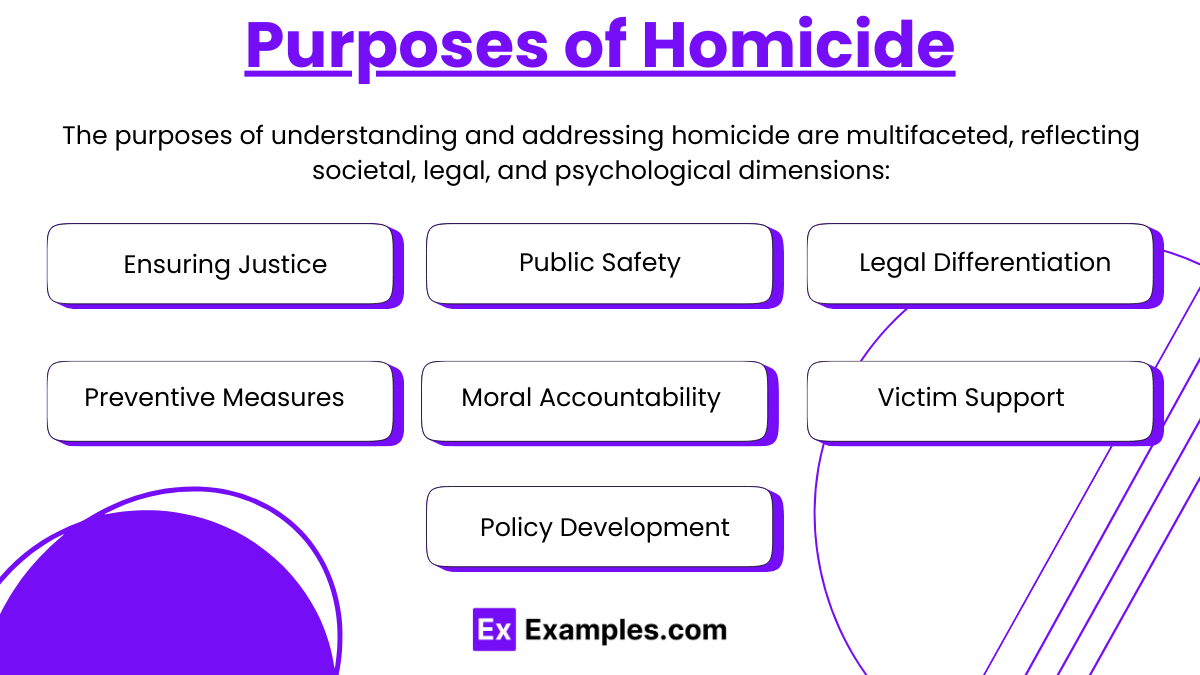
The purposes of understanding and addressing homicide are multifaceted, reflecting societal, legal, and psychological dimensions:
Ensuring Justice: To hold perpetrators accountable and ensure that victims and their families receive justice through fair legal proceedings.
Public Safety: To protect communities by identifying and addressing the factors that lead to homicide, thereby reducing the risk of similar acts.
Legal Differentiation: To classify and distinguish between types of homicide (e.g., murder, manslaughter, justifiable homicide) for appropriate legal responses and penalties.
Preventive Measures: To study the causes and patterns of homicide, enabling the development of strategies to prevent future incidents, such as conflict resolution programs or better mental health support.
Moral Accountability: To uphold societal values by recognizing the sanctity of life and addressing violations through a structured legal system.
Victim Support: To provide assistance, resources, and closure to the families and communities affected by homicide.
Policy Development: To inform lawmakers and policymakers in creating legislation that addresses the root causes of homicide and ensures effective deterrents.
Types of Homicide
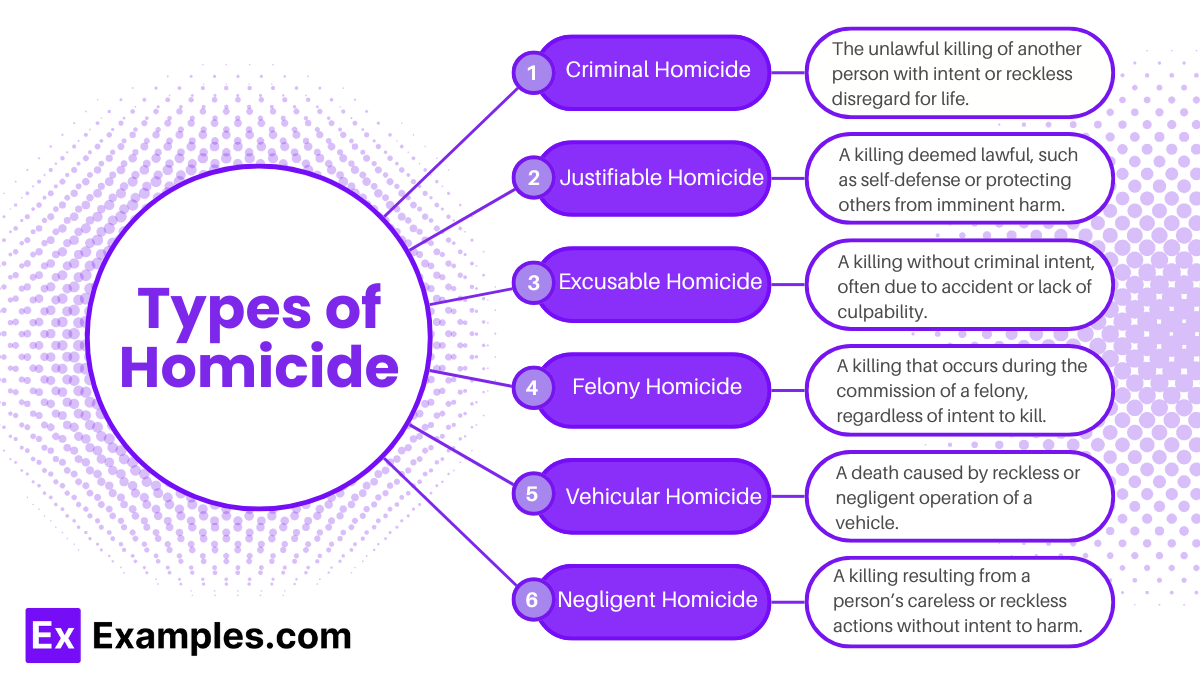
Homicide refers to the act of one person causing the death of another. It can be classified into different types based on the intent, circumstances, and legal definitions. Here are the primary types:
1. Criminal Homicide
Murder: Intentional killing of another person with malice aforethought. It is often further classified into degrees:
First-degree murder: Premeditated and deliberate killing.
Second-degree murder: Killing without premeditation but with intent or reckless disregard for human life.
Manslaughter: Killing without intent, divided into:
Voluntary manslaughter: Killing in the heat of passion, provoked by circumstances.
Involuntary manslaughter: Killing due to reckless or negligent behavior without intent to kill.
2. Justifiable Homicide
Killing that is deemed lawful, such as self-defense, defense of others, or in the line of duty by law enforcement officers when protecting life or property.
3. Excusable Homicide
Killing that occurs without criminal intent or negligence, such as in cases of accidents where the person acted with reasonable care and prudence.
4. Felony Homicide
Killing that occurs during the commission of another felony, even if the death was unintentional. This is often classified as felony murder.
5. Vehicular Homicide
Killing caused by reckless or negligent driving, often considered a separate legal category in many jurisdictions.
6. Negligent Homicide
Killing due to gross negligence, where the person failed to exercise a reasonable standard of care.
Important Doctrines in Homicide
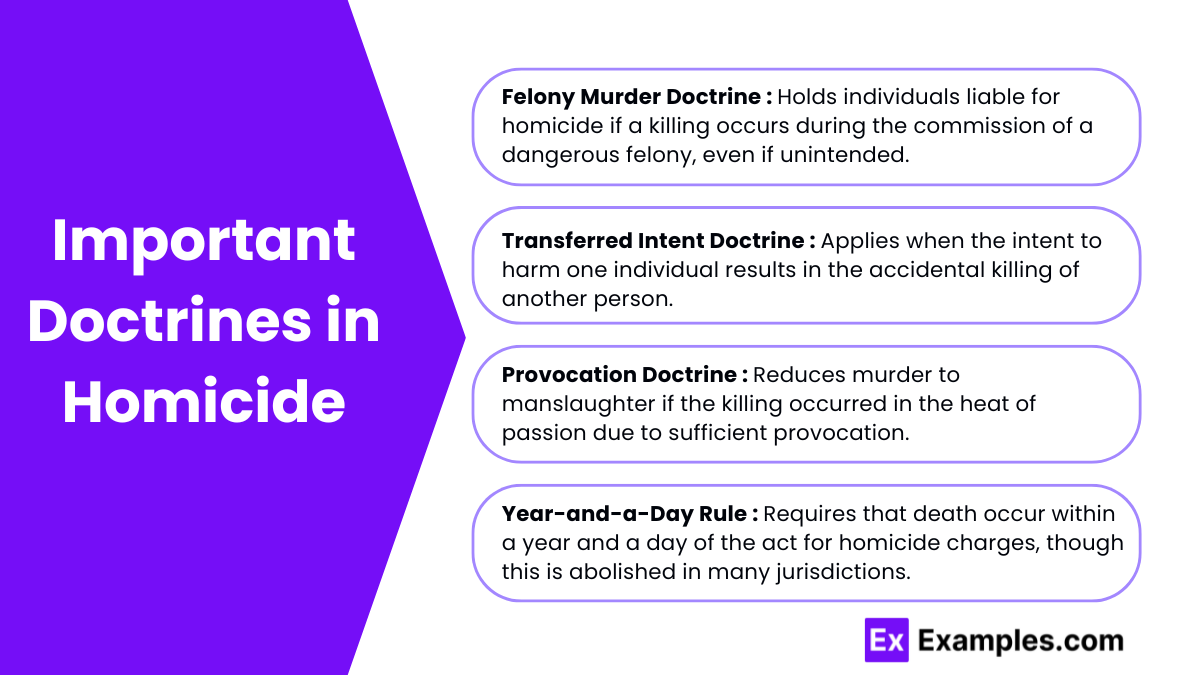
Felony Murder Doctrine: Holds individuals liable for homicide if a killing occurs during the commission of a dangerous felony, even if unintended.
Transferred Intent Doctrine: Applies when the intent to harm one individual results in the accidental killing of another person.
Provocation Doctrine: Reduces murder to manslaughter if the killing occurred in the heat of passion due to sufficient provocation.
Year-and-a-Day Rule: Requires that death occur within a year and a day of the act for homicide charges, though this is abolished in many jurisdictions.
Examples
Example 1. Legal Analysis
Homicide, a legal term for the killing of one person by another, is categorized into various types, including murder, manslaughter, and justifiable homicide. Understanding these distinctions is crucial in legal cases, as the intent and circumstances surrounding the act heavily influence charges and sentencing. For instance, a premeditated killing is classified as first-degree murder, carrying the harshest penalties.
Example 2. Psychological Insights
Researchers often analyze cases of homicide to understand the psychological factors that drive individuals to commit such acts. Factors such as a history of abuse, mental illness, and extreme emotional states are frequently examined. This knowledge aids in profiling potential offenders and implementing preventive measures.
Example 3. Forensic Investigations
In forensic science, investigating homicides requires meticulous attention to detail. Forensic experts gather evidence from crime scenes, such as DNA, fingerprints, and ballistic data, to reconstruct the events leading to the crime. These findings are essential for solving cases and securing convictions.
Example 4. Criminology Studies
The study of homicide trends provides insights into societal issues, such as economic disparities, gang violence, and substance abuse. Criminologists use this data to recommend policy changes aimed at reducing violent crime. For example, studies have shown a correlation between poverty and increased homicide rates, highlighting the need for socioeconomic reforms.
Example 5. Media Representation
Homicide cases are often sensationalized in the media, shaping public perceptions of crime and justice. High-profile cases, such as serial killings or crimes involving celebrities, attract widespread attention and often spark debates about the effectiveness of the legal system. This media focus can influence jury selection and trial outcomes.
Practice Questions
Question 1
Which of the following is the most accurate legal definition of homicide?
A) The intentional killing of a human being
B) The unlawful killing of a human being, either intentionally or unintentionally
C) The accidental killing of a human being without any negligence
D) The killing of any living organism, including animals
Correct Answer: B) The unlawful killing of a human being, either intentionally or unintentionally
Explanation:
Homicide is defined as the killing of one human being by another. It encompasses both lawful and unlawful killings. In the legal context, homicide includes murder (intentional unlawful killing) and manslaughter (unlawful killing without intent). Option B is the most accurate as it captures the breadth of the legal definition. Option A is incorrect because not all homicides are intentional (e.g., manslaughter). Option C excludes scenarios involving negligence, which are often classified as involuntary manslaughter. Option D is incorrect as homicide applies specifically to human beings.
Question 2
Which of the following distinguishes first-degree murder from second-degree murder?
A) The presence of premeditation and malice aforethought
B) The use of a deadly weapon
C) The number of victims involved
D) The involvement of law enforcement officials
Correct Answer: A) The presence of premeditation and malice aforethought
Explanation:
First-degree murder typically requires the presence of premeditation (planning) and malice aforethought (intent to cause death or serious harm). Second-degree murder, on the other hand, lacks premeditation but still involves malice aforethought. Option B is incorrect because both first- and second-degree murder can involve deadly weapons. Option C is irrelevant, as the number of victims does not determine the degree of murder. Option D is unrelated to the legal distinctions between murder degrees.
Question 3
Which of the following best describes voluntary manslaughter?
A) Killing that occurs during the heat of passion as a result of provocation
B) Killing that occurs due to reckless behavior without intent to harm
C) Killing that occurs as part of self-defense
D) Killing that occurs with premeditation and planning
Correct Answer: A) Killing that occurs during the heat of passion as a result of provocation
Explanation:
Voluntary manslaughter is characterized by the killing of another person in the heat of passion, often due to provocation that would cause a reasonable person to lose self-control. Option B describes involuntary manslaughter, which involves reckless or negligent actions leading to death without intent. Option C does not apply because killings in legitimate self-defense are generally not considered homicide. Option D describes first-degree murder, which requires premeditation.

